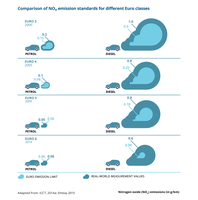
At least 21 EEA member countries have developed national adaptation strategies (NAS) or plans and that such strategies are under development in at least five additional countries (Bulgaria, Czech Republic, Estonia, Italy and Liechtenstein). The transport sector is specifically addressed in most of those strategies and plans with some detail (including countries such as Austria, Belgium, Denmark, Finland, France, Germany, the Netherlands, Poland, Slovakia, Spain, Switzerland and United Kingdom)

The different types of emissions from vehicles, and a comparison of the
relative amounts of selected pollutants released by the latest Euro 6 petrol
and diesel vehicles.

Real-world NOX emissions from petrol cars in the EU have decreased significantly since 2000, in line with the increasingly stringent emission limits. In significant contrast, the emissions from diesel cars have not improved much over the same period, meaning reductions from diesels have not been as large in reality as originally foreseen in legislation.

Flexibilities exploited by manufacturers during the NEDC test cycle can be broadlygrouped into two categories: those relevant to the initial coast-down test and thoserelevant to the type approval test itself.

Poor air quality is a serious health and environmental problem. Certain harmful air pollutants are emitted directly from vehicles, such as ‘primary’ particulate matter (PM) and nitrogen oxides (NOX). Others, such as ozone and ‘secondary’ PM, form in the atmosphere after emissions of precursor pollutants, including NOX and volatile organic compounds. Different sources of pollution, including transport and non-transport sources, emit different types and ratios of pollutants.

Dams on larger rivers in Europe. Dams dataset compiles dams included in ECRINS spatial database complemanted by dams located in Western Balkans region.

Floodplain percentage per subcatchment.

Results of 9 forest type assessments have been aggregated for biogeographic region (EU27).
Data aggregated from Eionet – ETC/BD 2015: Online report on Article 17 of the Habitats Directive (2007-2012).
http://bd.eionet.europa.eu/article17/reports2012/

Floodplain percentage per subcatchment.

Number of floods per 10 000 km2 per country.

A simplified model of the circular economy for materials and energy

Bathing water quality in the European Union in the 2011, 2012, 2013 and 2014 bathing seasons.

Absolute and relative difference between future (2041-2070) and present (1960-2010) summertime average daily and maxima ozone levels in a 9 model ensemble. The modelled changes shown are only due to climate variability and climate change. A diamond sign is plotted where the change is significant, and a plus sign is added where the change is robust across two-third of modelled years.
The period 2041-2070 is taken as representative of the middle of the 21st century (2050)

Absolute and relative difference between future (2071-2100) and present (1960-2010) summertime average daily and maxima ozone levels in a 3 model ensemble. The modelled changes shown are only due to climate variability and climate change. A diamond sign is plotted where the change is significant, and a plus sign is added where the change is robust across two-third of modelled years.
The period 2071-2100 is taken as representative of the end of the 21st century (2100)




